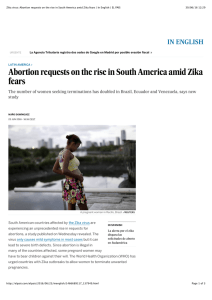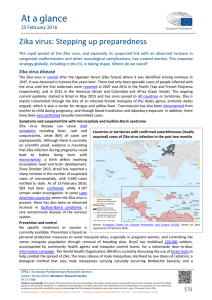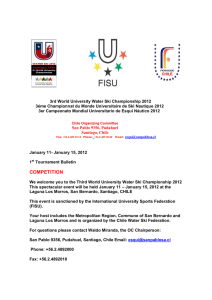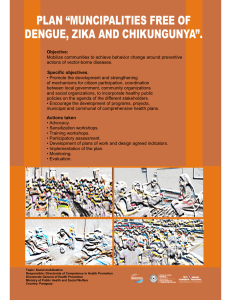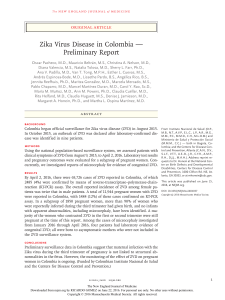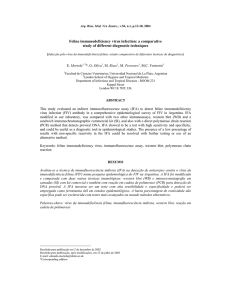Zika Virus Infection Presenting with Postauricular Lymphadenopathy
Anuncio
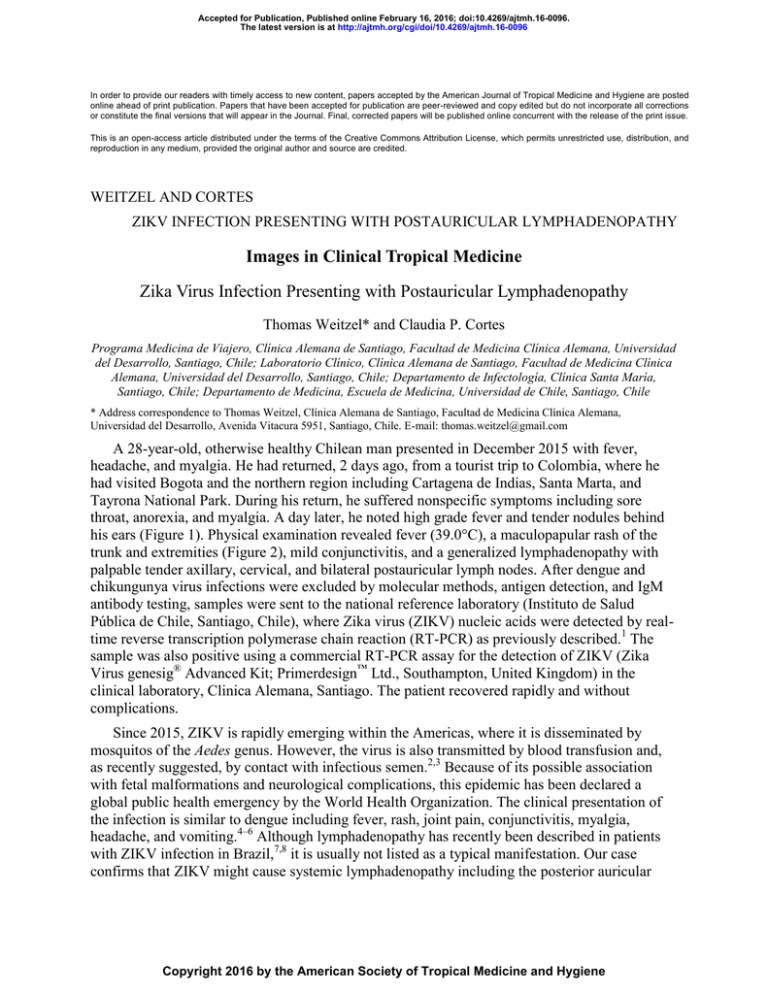
Accepted for Publication, Published online February 16, 2016; doi:10.4269/ajtmh.16-0096. The latest version is at http://ajtmh.org/cgi/doi/10.4269/ajtmh.16-0096 In order to provide our readers with timely access to new content, papers accepted by the American Journal of Tropical Medicine and Hygiene are posted online ahead of print publication. Papers that have been accepted for publication are peer-reviewed and copy edited but do not incorporate all corrections or constitute the final versions that will appear in the Journal. Final, corrected papers will be published online concurrent with the release of the print issue. This is an open-access article distributed under the terms of the Creative Commons Attribution License, which permits unrestricted use, distribution, and reproduction in any medium, provided the original author and source are credited. WEITZEL AND CORTES ZIKV INFECTION PRESENTING WITH POSTAURICULAR LYMPHADENOPATHY Images in Clinical Tropical Medicine Zika Virus Infection Presenting with Postauricular Lymphadenopathy Thomas Weitzel* and Claudia P. Cortes Programa Medicina de Viajero, Clínica Alemana de Santiago, Facultad de Medicina Clínica Alemana, Universidad del Desarrollo, Santiago, Chile; Laboratorio Clínico, Clínica Alemana de Santiago, Facultad de Medicina Clínica Alemana, Universidad del Desarrollo, Santiago, Chile; Departamento de Infectología, Clínica Santa María, Santiago, Chile; Departamento de Medicina, Escuela de Medicina, Universidad de Chile, Santiago, Chile * Address correspondence to Thomas Weitzel, Clínica Alemana de Santiago, Facultad de Medicina Clínica Alemana, Universidad del Desarrollo, Avenida Vitacura 5951, Santiago, Chile. E-mail: [email protected] A 28-year-old, otherwise healthy Chilean man presented in December 2015 with fever, headache, and myalgia. He had returned, 2 days ago, from a tourist trip to Colombia, where he had visited Bogota and the northern region including Cartagena de Indias, Santa Marta, and Tayrona National Park. During his return, he suffered nonspecific symptoms including sore throat, anorexia, and myalgia. A day later, he noted high grade fever and tender nodules behind his ears (Figure 1). Physical examination revealed fever (39.0°C), a maculopapular rash of the trunk and extremities (Figure 2), mild conjunctivitis, and a generalized lymphadenopathy with palpable tender axillary, cervical, and bilateral postauricular lymph nodes. After dengue and chikungunya virus infections were excluded by molecular methods, antigen detection, and IgM antibody testing, samples were sent to the national reference laboratory (Instituto de Salud Pública de Chile, Santiago, Chile), where Zika virus (ZIKV) nucleic acids were detected by realtime reverse transcription polymerase chain reaction (RT-PCR) as previously described.1 The sample was also positive using a commercial RT-PCR assay for the detection of ZIKV (Zika Virus genesig® Advanced Kit; Primerdesign™ Ltd., Southampton, United Kingdom) in the clinical laboratory, Clinica Alemana, Santiago. The patient recovered rapidly and without complications. Since 2015, ZIKV is rapidly emerging within the Americas, where it is disseminated by mosquitos of the Aedes genus. However, the virus is also transmitted by blood transfusion and, as recently suggested, by contact with infectious semen.2,3 Because of its possible association with fetal malformations and neurological complications, this epidemic has been declared a global public health emergency by the World Health Organization. The clinical presentation of the infection is similar to dengue including fever, rash, joint pain, conjunctivitis, myalgia, headache, and vomiting.4–6 Although lymphadenopathy has recently been described in patients with ZIKV infection in Brazil,7,8 it is usually not listed as a typical manifestation. Our case confirms that ZIKV might cause systemic lymphadenopathy including the posterior auricular Copyright 2016 by the American Society of Tropical Medicine and Hygiene lymph nodes. Because tender bilateral postauricular lymphadenopathy is a known clinical sign of postnatal rubella, it might mislead ZIKV diagnosis especially in pediatric patients. Received February 8, 2016. Accepted for publication February 11, 2016. Authors’ addresses: Thomas Weitzel, Clínica Alemana de Santiago, Facultad de Medicina Clínica Alemana, Universidad del Desarrollo, Santiago, Chile, E-mail: [email protected]. Claudia P. Cortes, Departamento de Infectología, Clínica Santa María, Escuela de Medicina, Universidad de Chile, Santiago, Chile. REFERENCES <jrn>1. Tognarelli J, Ulloa S, Villagra E, Lagos J, Aguayo C, Fasce R, Parra B, Mora J, Becerra N, Lagos N, Vera L, Olivares B, Vilches M, Fernández J, 2015. A report on the outbreak of Zika virus on Easter Island, South Pacific, 2014. Arch Virol (In press).</jrn> <jrn>2. Musso D, Roche C, Robin E, Nhan T, Teissier A, Cao-Lormeau VM, 2015. Potential sexual transmission of Zika virus. Emerg Infect Dis 21: 359–361.</jrn> <jrn>3. Musso D, Nhan T, Robin E, Roche C, Bierlaire D, Zisou K, Shan Yan A, Cao-Lormeau VM, Broult J, 2014. Potential for Zika virus transmission through blood transfusion demonstrated during an outbreak in French Polynesia, November 2013 to February 2014. Euro Surveill 19: 20761.</jrn> <jrn>4. Duffy MR, Chen TH, Hancock WT, Powers AM, Kool JL, Lanciotti RS, Pretrick M, Marfel M, Holzbauer S, Dubray C, Guillaumot L, Griggs A, Bel M, Lambert AJ, Laven J, Kosoy O, Panella A, Biggerstaff BJ, Fischer M, Hayes EB, 2009. Zika virus outbreak on Yap Island, Federated States of Micronesia. N Engl J Med 360: 2536–2543.</jrn> <eref>5. Pan American Health Organization, World Health Organization, 2015. Epidemiological Alert: Zika Virus Infection, 7 May 2015. Available at: http://www.paho.org/hq/index.php?option=com_docman&task=doc_view&Itemid=270&gid =30075&lang=en. Accessed February 4, 2016.</eref> <eref>6. European Centre for Disease Prevention and Control, 2016. Factsheet for Health Professionals. Available at: http://ecdc.europa.eu/en/healthtopics/zika_virus_infection/factsheet-healthprofessionals/Pages/factsheet_health_professionals.aspx. Accessed February 4, 2016.</eref> <jrn>7. Zanluca C, de Melo VC, Mosimann AL, Dos Santos GI, Dos Santos CN, Luz K, 2015. First report of autochthonous transmission of Zika virus in Brazil. Mem Inst Oswaldo Cruz 110: 569–572.</jrn> <jrn>8. Marcondes CB, Ximenes MF, 2015. Zika virus in Brazil and the danger of infestation by Aedes (Stegomyia) mosquitoes. Rev Soc Bras Med Trop (In press).</jrn> FIGURE 1. Bilateral tender postauricular lymphadenopathy in patient with Zika virus infection. This figure appears in color at www.ajtmh.org. FIGURE 2. Maculopapular rash on the patient’s arm. This figure appears in color at www.ajtmh.org. Figure 1 Figure 2

